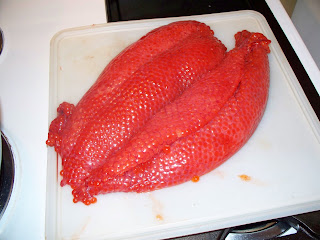One of the reasons we live in the Pacific Northwest is our close proximity to the ocean. Even though we LOVE the mountains, it would be very difficult to live in a land-locked state and not have access to fresh seafood year-round.
And when I say fresh, I mean FRESH. Often times you can buy fish right off of the fishermen's boats as they are coming back to the docks. And sometimes, it is quite a "deal". We just bought about 100 lbs. of fresh caught salmon. When all of the math was done, it ended up costing us $1.12/lb.
Did we just rob a land-hungry, unsuspecting fisherman?
I just priced the same fish at our local grocery store. It was on sale for $12.99/lb.
So, who are the thieves?
~~~~~~
We needed to process our fish fairly quickly, so we decided to freeze some and can the rest. First, my Mister filleted the fish to make them easier to handle.
The thickest part of the fish became roasts. The tail end, and strips below the ribcage, without the bones, were made into smaller pieces for fish & chips. The meat that was the least attractive was canner-bound.
To skin the salmon, my Mister slid a very sharp knife between the skin and the meat. The key word is "sharp". It is not a word that I recognized.
These are our roasts, waiting to be packaged.

See how clean the skin is? That's because of the sharp knife.
That I do not have.

To can the salmon, we stuffed skinless pieces into pint-sized jars, about 1/2" from the top of the jar. Then we placed the hot lids on top and screwed the rings down tight. Because they were going into a pressure canner, the jars were new. When canning fish, we only reuse the fish jars twice, then they end up in the water-bath only section. Pressure canning weakens the glass and breakage is more likely to occur after a couple of uses.
Our pressure canners are stackable, so we were able to fit 14 into one, and 16 into the other.
Boy, do I love that!
Here's how to can fish...
Place the jars into the canner, then add 2-3 quarts of hot water. Place the canner lids on and turn on the heat. We used our propane cookstove, so we heated the canner up slowly. When the steam is coming out of the vent tube at a steady pace, place the cap on it and let the pressure build up to 10 lbs.

You will need to adjust your heat regularly. Don't be alarmed if the pressure hits 15 lbs., just turn down the heat a little. Once you've reached 10 lbs., set the time for 110 minutes.

When the time goes off, turn off the heat and let the canner sit, undisturbed until the pressure gauge points to 0.
There are no exceptions to this rule. EVER.
After the gauge reads zero, remove the cap to let any leftover steam escape before removing the lid.
Carefully remove the jars and set them on a covered table. Put a bathtowel over the top and let them cool overnnight.

Make sure that you label the jars! This is especially important if you can more than one kind of fish!
My kids had a very expensive salmon-fish sandwich last year.

We were fortunate enough to discover egg sacks in a couple of the fish.
I found a recipe and this became salmon "caviar".



4 comments:
Thanks for the ideas Kim. Next year on our vacation to the coast I want to acquire salmon in abundance next year. I was a little unsure what to do with it - I was thinking about smoking it, but canning seems like a good idea. I was not so fond of the crab, but we will probably try it again.
Wow Kim!
That is pretty amazing. I lived in Oregon for 20 years and never attempted canning any fish. You make it look fairly easy :-) $1.12 a pound is amazing. And what a bonus for the roe.
My Grandmother used to serve us canned salmon, canned beef or canned chicken for Sunday Faspa (Mennonite afternoon cold lunch). I try to can Ocean Salmon whenever we find it in the grocer. It is well worth the effort - isn't it!?
Good work you two!
I don't know how it's possible that I missed this post but some how, I did. $1.12/lb???!!! Seriously? A price like that makes me want to drive to WA just to get my hands on some for that inexpensive! :) Hope you still have a couple of those jars left! :)
Post a Comment